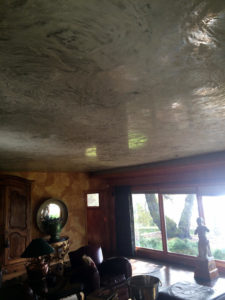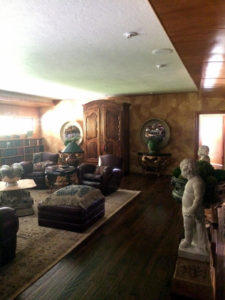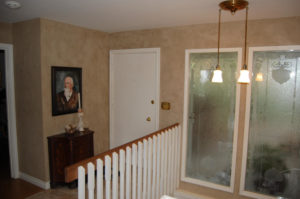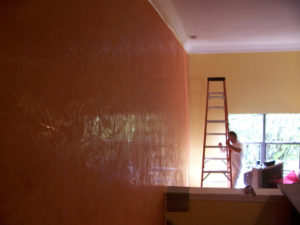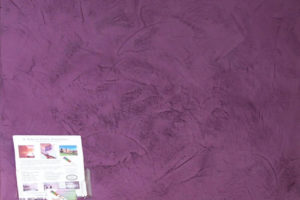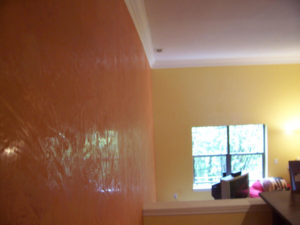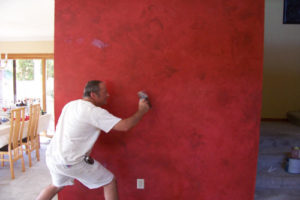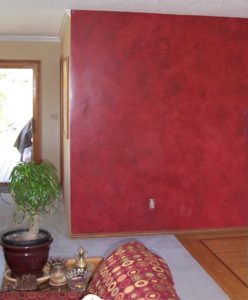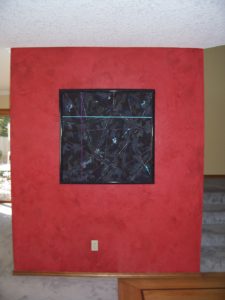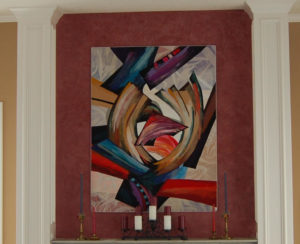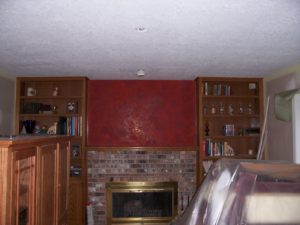Portland, Oregon Venetian Plaster
Venetian plaster is an ancient art medium that has been perfected and used over the centuries. It is used in a surprising variety of ways. It often gives the impression of stone, great age, or any number of natural materials. We use a variety of techniques and styles. With even one color Venetian gives a depth of hues and shades. We can use additional colors, stenciling, and texture patterns to create beautiful effects. We work with you find colors and techniques to fit your style, needs and desires.
Venetian plaster, or Venetian stucco, has been used for centuries around the world, in homes and offices, on architectural masterpieces and in everyday buildings. Architects and interior designers, home-owners and artists, all have marveled at the distinctive beauty of this highly popular form of wall surfacing, and throughout the ages the artisans who were skilled at creating such beauty have been revered and sought after.
It is distinctive, subtly graduated in color, and can have a rough finish although traditionally it is shiny and many-layered. This shiny surface draws the touch, as though one’s fingers would not stop at the surface itself but sink into it as easily as into a pool of cool water.
The term “Venetian Plaster” was coined in the early 80’s here in the USA because of its origins in the Venetian Region in Italy. “Venetian Plaster” or “Italian Plaster” usually refers to a polished plaster, either lime or resin. In Italy, the term “Venetian Plaster” is not used; the plasters are called “Decorative Stuccos”. Most of our Venetian Plasters can be used indoors or outdoors.
Schedule your Venetian Plaster Bid
As far back as 1628 the priest Vincenzo Requeno experimented with combinations of plaster, lime and wax the same ingredients the Egyptians used to preserve many of their monuments. Over time, the technique of finishing layers of plaster with hvenetian plaster, faux finish, faux, finish, Venetian, plaster, Italian plaster, Decorative Stucco, stucco, portland, oregon, house, home, wall art, painting, behr, marmorino, modern masters, plaster application, venetian plaster technique, venetian plaster faux paintingeated iron tools and a variety of other materials became the ideal for protecting and enhancing great architecture.
Even after being buried by the volcano Vesuvius for over two-thousand years ancient Roman frescoes survived in the villas of Pompeii. Entire towns were freed from the ashes to reveal interior decorations that out lasted their Roman civilization. At Pompeii, one particular procedure consistently preserved the quality of colors on ancient walls. It endured the damage of heat, time, soil, and atmospheric conditions better than even modern frescoes techniques.
“Kurt and Paul did the Venetian plastering of a long, cathedral-ceilinged wall running from our dining area through the living room. They were punctual, stuck to the budget they quoted us, and took great care with protecting the rugs and furniture. I liked the way they offered us alternative ways of approaching the job and explained the choices clearly while letting us make the final decisions. The results were beautiful, and I would recommend them to anyone for this kind of wall treatment.”
~Ditty Nicolaides & Ernie Jurick
Portland, OR
“Kurt and Paul spent hours with us patiently going over color choices for every room. They had a wide array of sample chips and were very helpful without being the least bit pushy. We had originally asked for a ragging technique for the walls in the salon above the wooden wainscoting. Kurt suggested a Venetian plaster and showed us a sample. It added . . . to the price, but it was well worth it. Kurt spent hours prepping the walls, applying the plaster in coats, and then burnishing the surface with a trowel to give it a textured appearance. The room looks fantastic! Their paint work was equally skilled; the cut lines are absolutely perfect, and the transformation from plain white walls to warm colors throughout is amazing.” MAGGIE LYNCH
Ancient History of Venetian Plaster
Limestone is one of the world’s most common materials, readily available worldwide. It has been used for thousands of years as the main component of stucco, mortar and plasterwork. The pyramids of Egypt contain plasterwork from at least 3000 B.C.E. showing a remarkable level of refinement. According to 19th-century authority William Miller, in his book Plastering Plain and Decorative, in Pompeii, and later ancient Rome, the craft of plastering reached new heights with the introduction of multi-layered plaster using fine marble dust as an aggregate. The final coats were burnished and colored either integrally, or a fresco. Architect and engineer Vitruvius described a seven-step process for producing a finished wall in the first century B.C.E. Several layers of coarse plaster leveled the rough Roman masonry and acted as a base for the finer finishing layers that included finely ground marble dust. The walls were then soaped and waxed to protect them. The finishes were called opus marmoratum owing to their marble-like hardness and beauty.
Vitruvius describes a seven-step process for making Venetian plaster, where several layers of coarse plaster leveled the rough Roman masonry and acted as a base for the finer finishing layers that included finely ground marble dust.
The process remained essentially unchanged through two millennia. It was rediscovered during the Italian Renaissance, acquiring the name “marmorino.” “Pietra d’Istria” was its moniker when revived again by Palladio in 18th- and 19th-century Venice. The latter name referred to the pure white marble that was used as the aggregate. The processes remained faithful to the ancients through the 1950s, when it had another revival by the Italian architect, Carlo Scarpa. However, he also introduced some significant changes, diverging from the traditional craft, and creating a new type of finish.
In conjunction with his craftsman Eugenio De Luigi, Scarpa created “Pastellone Scarpiano,” also known as Stucco Lustro. This was the precursor to today’s synthetic Venetian plaster. It was made with fine marble dust as per the ancients, but replaced the lime matrix at first with hide glues and other materials, and later with acrylic resins. This substitution was an elemental change, since lime-based plasters take advantage of what is known as the “Circle of Lime.” This is the unique ability of limestone to transform from raw stone into kiln-fired quicklime through slaking with water into a thick putty. Once applied to a wall and combined with marble dust, it converts back into limestone. Lime-plastered walls re-crystallize over time by absorbing carbon dioxide from the air, chemically changing back into limestone, while acquiring the hardness and crystalline beauty unlike that of any other finish.
Not all Venetian Plaster is the same. Some procedures are recognized as ‘classics’ in the Italian tradition, and different regions of Italian have their own techniques. They each have different formulas and are known by many names and: Stucco ad Encaustic, Grassello, Marmorino, Intonachino, Coccio Pesto, and Stucco Fiorentino. Most of the formulas are closely kept secrets, passed down in families and among craftsmen much like in the days of the Guilds and studios of the Renaissance.
Recent advances have introduced many new methods, techniques and materials.
Portland, Oregon Faux Finishing

